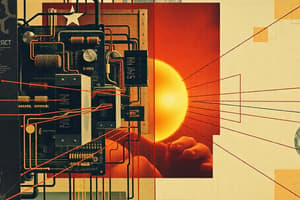Podcast
Questions and Answers
What is the role of semiconductors in modern electronics?
What is the role of semiconductors in modern electronics?
- To increase the size of electronic components
- To enhance the conductivity of metals
- To replace insulating materials in electronic devices
- To enable faster and smaller electronic components (correct)
What is a P-N junction?
What is a P-N junction?
- A term for the resistance in a circuit
- A highly insulating material used in electronics
- A component that increases the temperature of the circuit
- A type of boundary between two different types of semiconductor materials (correct)
How do P-N junctions control current flow?
How do P-N junctions control current flow?
- By blocking it until certain conditions are met (correct)
- By decreasing the voltage across the circuit
- By always allowing maximum current flow
- By increasing resistance in the circuit
What is band theory primarily concerned with?
What is band theory primarily concerned with?
In band theory, what are the 'valence band' and 'conduction band' responsible for?
In band theory, what are the 'valence band' and 'conduction band' responsible for?
How have semiconductors revolutionized our world?
How have semiconductors revolutionized our world?
What is the most common example of a semiconductor device mentioned in the text?
What is the most common example of a semiconductor device mentioned in the text?
Why has silicon replaced germanium as a standard material for transistors?
Why has silicon replaced germanium as a standard material for transistors?
What type of materials are semiconductors based on their atomic structure?
What type of materials are semiconductors based on their atomic structure?
Which semiconductor device is mainly used in the control of AC motors driving machinery?
Which semiconductor device is mainly used in the control of AC motors driving machinery?
What role do semiconductors play in enabling efficient communication between devices?
What role do semiconductors play in enabling efficient communication between devices?
Why do researchers design better semiconductor materials suited for specific tasks?
Why do researchers design better semiconductor materials suited for specific tasks?
Flashcards are hidden until you start studying
Study Notes
Semiconductors
Semiconductors play a crucial role in modern electronics due to their unique properties between conductive metals and insulating nonconductive materials. They have revolutionized our world by enabling smaller and faster electronic components, such as transistors and diodes. These small parts of computer chips pave the pathway towards increasing efficiency in computing power while reducing energy consumption simultaneously. Below we'll cover some key concepts related to this technology:
P-N Junctions
A P-N junction is a type of boundary between two different types of semiconductor material—one being heavily doped with one kind of charge carrier (either electrons or holes), and the other being lightly doped with the opposite kind of charge carrier. This combination creates a neutral region where the charges from each side combine, creating a barrier known as depletion layer. P-N junctions can control current flow by blocking it until certain conditions are met, making them essential in digital circuits like transistors.
Band Theory
Band theory deals primarily with the energy levels present within a given substance so that we can predict how well it will function as a conductor or insulator. In any pure elemental or chemical compound, there exists both a 'valence band' and a 'conduction band.' When an electric field is applied across these bands, the electrons shift positions causing movement of electrical currents through the material. This relationship allows us to understand why some materials become conductors when heated, while others do not.
Semiconductor Devices
The most common example of a semiconductor device is the transistor, which plays a vital role in computers and many consumer products today. Transistors allow for controlling high voltages using low voltage signals, amplifying weak radio waves into powerful broadcast frequencies, converting analogue signals into digital ones, filtering out noise from audio systems etc.. Other important semiconductor devices include light emitting diodes (LEDs) used mostly in displays and backlight applications; photodetectors detect visible, ultraviolet light, and infra-red radiation in various instruments; solar cells convert sunlight directly into electricity; and thyristors are used mainly in the control of AC motors driving machinery.
Semiconductor Materials
Silicon has been found to be particularly useful because it forms crystalline structures that lend themselves easily to manufacturing processes. Silicon has replaced germanium as a standard material for transistors because silicon does not require heat treatment after etching away unwanted areas during manufacture. Some other commonly used semiconductors include gallium arsenide (GaAs), indium phosphide (InP), cadmium sulfide (CdS), mercury telluride (HgTe), lead sulfide (PbS), and lead selenide (PbSe). Each of these has its own set of advantages and limitations based upon specific application needs.
Semiconductor Physics
Atomic structure plays a huge part in understanding how electrons move around within a semiconductor crystal lattice. Electrons donate valance electrons freely instead of bonding tightly together in metal atoms. Understanding this behavior helps researchers design better semiconductor materials suited for specific tasks like improving battery life or solar cell efficiency. Quantum mechanics also helps scientists develop theoretical models describing phenomena occurring deep inside solid state matter - something previously too complex for traditional quantum mechanics alone.
In summary, semiconductors enable efficient communication between devices due to their ability to change states according to external stimuli without becoming damaged. Their versatility and adaptability make them ideal candidates for future technological advancements, especially as demand increases for compact integrated circuitry capable of handling vast amounts of information quickly and efficiently.
Studying That Suits You
Use AI to generate personalized quizzes and flashcards to suit your learning preferences.




